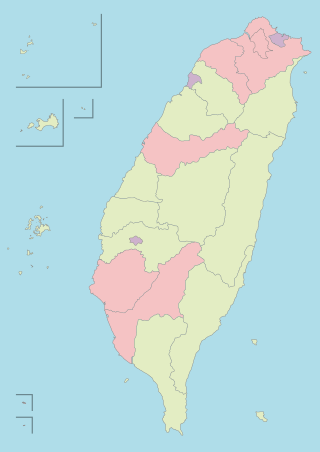Top Qs
Timeline
Chat
Perspective
Provincial city (Taiwan)
Type of administrative division of the Republic of China (Taiwan) From Wikipedia, the free encyclopedia
Remove ads
An autonomous municipality,[1] county-level city or city,[I] previously provincial city, is a de jure second-level administrative division unit in the Republic of China (Taiwan).[2]
The provincial cities were formerly under the jurisdiction of provinces, but the provinces were streamlined and effectively downsized to non-self-governing bodies in 1998, in 2018 all provincial governmental organs were formally abolished.[2][3] Provincial cities along counties, are presently regarded as de facto principal subdivisions directed by the central government of the ROC.
Remove ads
History
Summarize
Perspective
The first administrative divisions entitled "city" were established in the 1920s when Taiwan was under Japanese rule. At this time cities were under the jurisdiction of prefectures. After the World War II, nine (9) out of eleven (11) prefectural cities established by the Japanese government were reform into provincial cities. Their roman spellings are also changed to reflect the official language shift from Japanese to Mandarin Chinese, but characters remain the same.
The reform was based on the Laws on the City Formation (市組織法) of the Republic of China. This law was passed in the early 20th century. The criteria for being a provincial city included being the provincial capital as well as having a population of over 200,000, or over 100,000 if the city had particular significance in politics, economics, and culture. The division reform in 1945 had some compromises between the Japanese and the Chinese systems, some of the cities with population under the criteria were still be established as provincial cities.

After the government of the Republic of China relocated to Taipei, Taiwan in 1949, the population criterion for provincial cities was raised to 500,000 in the Guidelines on the Implementation of Local Autonomy in the Counties and Cities of Taiwan Province (臺灣省各縣市實施地方自治綱要), which was passed in 1981. It was later raised again to 600,000. Since the streamline of provinces in 1998, provincial cities are all directly under the central government, and are simply referred to as cities.
The People's Republic of China (PRC), which claims Taiwan as its 23rd province, has all of its provincial cities classified as county-level city.
Remove ads
Current cities
Summarize
Perspective
Currently, the Local Government Act of the Ministry of the Interior applies for the creation of a city, in which a city needs to have a population between 500,000 and 1,250,000 and occupies major political, economical and cultural roles.[5] Note that all three existing cities are not qualified for the population test, they were built for historical reasons.
There are currently three cities, all in Taiwan Province:
Their self-governed bodies (executive and legislature) regulated by the Local Government Act are:
Remove ads
See also
- Notes
Notes
- Also known as the Taiwan area or Tai–Min area (Chinese: 臺閩地區; lit. 'Taiwan–Fujian area')
- The mainland area consists of Mainland China, Tibet and (previously) Outer Mongolia
- Special municipalities, cities, and county-administered cities are all called shi (Chinese: 市; lit. 'city')
- Constitutionally having the same structure as the free area, these are currently under the Chinese Communist Party control with a different structure
Words in native languages
- Traditional Chinese script: 市
- Mandarin Pinyin: Shì
- Hokkien: Chhī
- Sixian Hakka: Sṳ
Remove ads
References
Wikiwand - on
Seamless Wikipedia browsing. On steroids.
Remove ads

